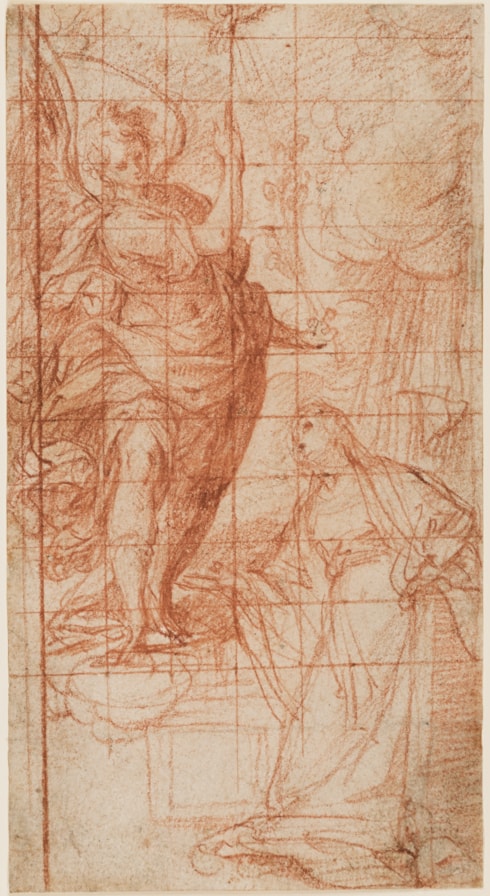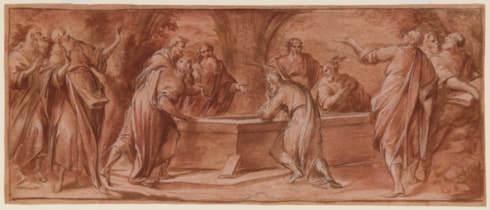
Camillo PROCACCINI
Bologna 1561 - Milan 1629
Biography
Born into a family of Bolognese artists that included his father Ercole and younger brothers Giulio Cesare and Carlo Antonio, Camillo Procaccini was trained in the late Mannerist artistic milieu of Bologna. He was, for a time, a colleague and contemporary of the Carracci, in whose academy he taught, and also painted part of the predella of Ludovico Carracci’s Annunciation altarpiece of 1585. Procaccini undertook study trips to Parma, to see the works of Correggio, and to Rome, where he was especially inspired by the frescoes of Raphael and Michelangelo. All of these influences are evident in his first major independent work, the fresco decoration of the apse of the church of San Prospero in Reggio Emilia, painted between 1585 and 1587. In 1587 Procaccini moved to Milan, at the invitation of his Milanese patron Count Pirro Visconti Borromeo, and was joined there by his father and brothers. He enjoyed a highly successful career for the next forty years, executing numerous paintings for the Duomo (one of first non-Lombard painters to be invited to work in the cathedral) and numerous other churches in Milan. An altarpiece of The Martyrdom of Saint Agnes, painted in 1591 for the Duomo, and organ shutters painted for the same church the following year, are among his most important works in Milan. Together with his brothers Giulio Cesare and Carlo Antonio, Procaccini also worked on the decoration of the church of Sant’Angelo in Milan for over twenty years. He received numerous commissions for paintings for churches and palaces in other towns throughout the State of Milan and Lombardy, as well as in his native Emilia and further afield; in Venice, Genoa and the Canton Ticino in Switzerland.
The subjects of Procaccini’s religious paintings, depicted with narrative clarity and expressive force, served to emphasize the tenets of the Counter Reformation, and the artist came to dominate the artistic scene in Milan in the latter half of the 16th century. He painted altarpieces for almost every major church in Milan, and also received important commissions for easel pictures, such as a dozen large canvases of scenes from the life of the Virgin painted for the Spanish governor of Milan, Pedro de Toledo Osorio, between 1616 and 1618. The scale, complexity and inventiveness of his work so impressed the 18th century biographer and historian Luigi Lanzi that he described Procaccini as ‘the Vasari and the Zuccaro of Lombardy’. Among the significant projects of the artist’s late career were the decoration of the nave and apse of the Duomo in Piacenza, painted in collaboration with Ludovico Carracci between 1605 and 1609, and the frescoes on the vault of the choir of Santi Paolo e Barnaba in Milan, completed in 1625.
A gifted draughtsman, Camillo Procaccini was greatly admired as such by some of his major patrons, such as Pirro Visconti. He produced a number of highly finished drawings - studies of male nudes, mythological scenes and grotesque heads - which seem to have been intended as independent works of art for the collector’s market, and also established a successful drawing academy in Milan. That his drawings were popular among collectors in his lifetime is seen in the comments of a contemporary connoisseur, Girolamo Borsieri, who describes Procaccini as ‘he who, by those who know the excellence of the paintings, is praised as the master among modern draughtsmen, the one who in the smallest sketch observes the rules of perspective and of movement’, adding that ‘To obtain drawings by Procaccini…is more the fortune of a great prince than the reward of a private, albeit worthy connoisseur...I would almost stop trying to find them.’ Significant groups of drawings by Procaccini are today in the Biblioteca Ambrosiana and the Castello Sforzesco in Milan, as well as the Uffizi in Florence, the British Museum, the Louvre, the Accademia in Venice and the Royal Library at Windsor Castle. Procaccini also produced a handful of etchings, all of religious subjects, during his time in Milan, several of which are dated 1593.



